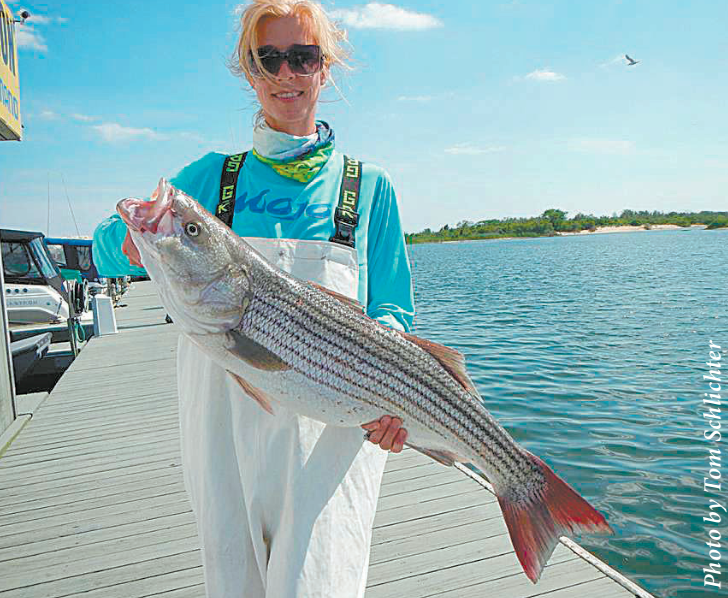With massive schools of bunker riding up the West End, South Shore and western Long Island Sound each May for the past few years, striper fans have been delighted with aggressive linesiders that will smash poppers, tins and live bait. Still, there are days, especially if the bunker schools are spread out, when covering ground is the best way to catch up to the heavy hitters. Under those conditions, trolling large bunker spoons is a great way to connect. This approach, however, entails more thought than simply dragging a couple of big metal lures behind your transom.
“There are a few areas where novice trollers tend to miss the mark,” says Capt. Joey Leggio, of www.ChasinTailTV.com. “The first one is when they play mix-and-match with the spoons. Each bunker spoon manufacturer balances their spoons slightly differently. That means that, at any given trolling speed, each will have a slightly different action. You wouldn’t, for example, troll a Tony Maja spoon and at TGT spoon together. To do so would result in one spoon working more smoothly than the other or, even worse, both spoons swimming awkwardly and performing badly.”
Another problem beginning trollers often encounter is figuring out the right trolling speed. Getting the speed just right requires more thought than most anglers realize up front.
“I hear guys on the radio ask all the time: “Hey, Buddy, what speed are you trolling at?” says Leggio. The problem with that question is that there is no set speed, it is always a factor of variable of sea conditions, tidal direction, wind and current speed and it needs to be constantly adjusted.”
Leggio likes to start out with what he calls his “foundation speed.” Generally, that’s 3 knots per hour. He then adjusts his speed based on prevailing conditions at that very moment and constantly adjusts or fine-tunes his presentation while under way. “Will you be trolling cross- current, with the current or against the current? he asks rhetorically. “Each direction will see your spoon work differently. Into the current, you’ll need to troll slower. With the current you may need to go as fast as 5 knots to get the right action out of your spoons. If you angle the current or cut across it, you’ll probably need to settle at an in-between rate.”
The secret to getting your trolling speed just right, it turns out, can be found right in your rod tips. When bunker spoon is working properly, you see, it glides predictably from side to side. This is reflected in a smooth, rhythmic pumping actin of the rod tip. Watch that tip and it will tell if your speed is properly adjusted or if you need to push down or pull back on the throttle.
“If the rod tip pumps quickly and erratically,” continues Leggio, “that means the spoon is spinning so you’ll need to slow down until the tip begins to pump with a regular, rhythmic action. Often that happens when trolling into the current. On the other hand, if the rod tip is not pumping enough, you’ll need to speed up. This is usually the case when trolling with the current. Either way, you trolling speed can vary from less than 2 knots to 4 or 5 knots.
Those fastest speeds usually a skipper pulling his spoons in the same direction as a strong current and having the wind at his back. “If you troll in the same direction as the current, you’ll need to go pretty fast once it gets pushing,” says Leggio. “You’ve got to be going faster than the current to get the action right. No matter which way you go, though, the rod tip should show that steady, rhythmic pumping action – pump, pump, pump, pump. If the rod just stops pumping without a current, wind or direction change, you’ve probably got weeds stuck on the hook so reel in, clean up and reset your spoons.”
While Leggio always trolls identical size and brand spoons, he’ll usually start out with two different colors. His favorite choice is the Tony Maja, Adult Bunker/Porgy pattern in size 4. When using these spoons, he’ll start with a multi-color pattern like green/chartreuse and matches it up with a white spoon. If one lure starts out-producing the other, he’ll swap out the less productive one to troll identical colors and hopefully increase his productivity.
Keep in mind that bunker spoons work great in the fall, too – even if the bunker aren’t running thick – because they allow skippers to cover a tremendous amount of water very quickly. Another time when they can work very well, interestingly, is when there are so many bunker around that the bass and blues can be spread out simply because there aren’t enough of them to cover the majority of baitfish pods. In that instance, you can troll from one bunker pod to the next, picking your way through massive schools until hitting pay dirt. It’s a tough way of fishing, requiring excellent boat-handling skills and pin-point precision to position the lures alongside various pods while making your way through the entire bunker community – but it’s soooo sweet when things go right.
Although there are no guarantees with any method of fishing, trolling bunker spoons tends to target bigger fish. Don’t be surprised to encounter double-digit gorilla blues and figure most stripers will fall in the 15- to 25-pound class whether taken from the ocean or Long Island Sound. That’s some quality fishing; the kind that gets hearts racing. Just remember that, as with any other kind of fishing, it’s the little things that count so much. In this case, simply keeping an eye on the rod tips. That’s where you’ll always find the measure of your lure’s action.










